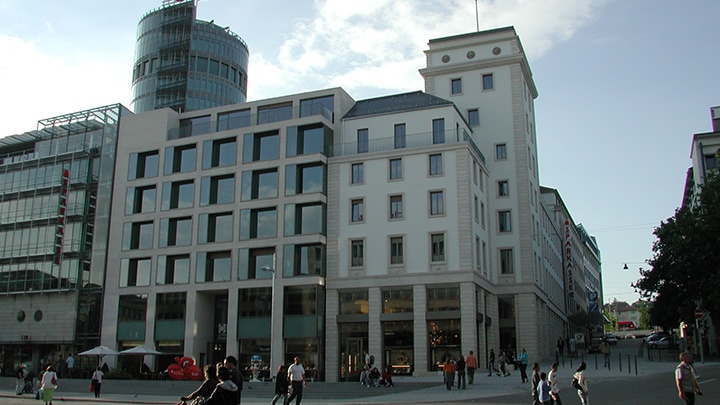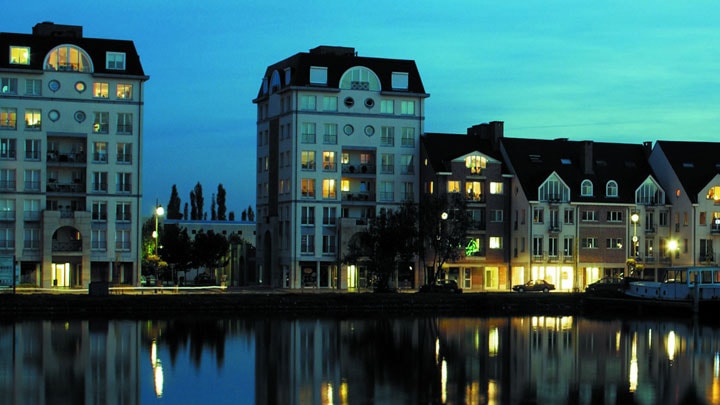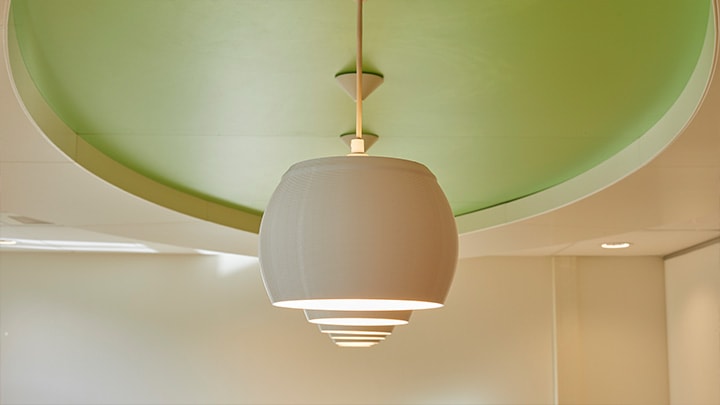
You may click on the image above to view the complete recording on YouTube.
While you may view the webinar you also will have an opportunity to appear for a short quiz and obtain the certificate if you successfully pass the quiz. Login here to take the assessment and obtain the certificate.
Brightening the world we live in with our new form of digital craftsmanship. Today’s choice in lighting is 3D printed. We enable you to create remarkable and sustainable lighting designs. Fitting your brand and spaces seamlessly. Delivered directly to your business. Saving on time, energy, waste and transportation. Amazing shapes, mesmerizing colors, unique textures.
3D printed lighting is the sustainable choice in lighting. Eliminating waste by using recycled materials. Contributing to the circular economy by design and reducing CO2 emissions by printing locally. Instant development and printed at lightspeed.
Join Bart Maeyens during this lecture. His talk will be a door opener, demystifying and inspirating. What are the the possibilities and “impossibilities”, the do's and the dont's.
Your chance to learn more or to ask any question you might have to the leader of Philips MyCreation
Learning objectives:

Bart Maeyens
Leader, 3D Printing
Signify
Bart Maeyens is a leader with a passion for people, light, and sustainability.
He combines his love for beauty and technical innovation. Always striving, with his teams, for a balance between impact and learning.
As a leader in 3D printing at Signify, he contributes to the mission of creating "brighter lives and a better world" through circular lighting solutions.
At Modular L.I., Bart's roles as General Manager, R&D Manager, and Export Manager showcased his commitment to design, innovation, and global customer-centric approaches.
His extensive experience as a Key Account Manager and R&D specialist highlights his ability to create efficient and aesthetically pleasing lighting solutions.
Bart's remarkable journey began as an R&D assistant, and he continues to drive positive change in the lighting industry with boundless enthusiasm and a collaborative mindset.
Q 1. How did you solve the high cost associated with 3D printing production parts compared to injection molding?
Ans. The cost was never really an issue. From the start, 3D printing was cheaper in total cost of ownership for a luminaire. We decreased costs of our parts by printing much faster (up to 10x faster vs regular of the shelve printers). Automating our production setup and digitalizing all process and infrastructure. Printing more complex parts that reduce the overall required parts for a luminaire >40% and decreasing the overall mounting costs. Subtract the fact that we do not require the molds and can still vary each print cycle (being much more flexible) and we become much cheaper, more flexible and way more sustainable that conventional manufactured products. Subtract that your warehouse space can be reduced tremendously, and obsolescence can be avoided as you print / order. There was never a price gap. The other way around is the reality now, we drive away (in the right direction) compared to conventional. 😊
Q 2. Hi, will the fixtures melt in a fire? Thx
Ans. All our fixtures are fire rated according to the glow wire regulation on 850°C for public buildings. That even means that most private or non-public fixtures do not have this and we do. They are top in class when it come to fire-safety.
Q 3. Please look at the paper: Acrylonitrile Butadiene Styrene (ABS) and Polycarbonate (PC) Filaments Three-Dimensional (3-D) Printer Emissions-Induced Cell Toxicity. If you are using PLA, there is a microplastic pollution
Ans. That is indeed why we do not use it. We use PC at a grade and setup that avoids the above-mentioned issue completely
Q 4. https://www.sciencedirect.com/science/article/abs/pii/S0269749120362977
Ans. Hope you also read the article. The problem is always the same when it comes to human made compounds, production, or waste treatment. The issue is hardly ever the material itself. Human beings are the issue. Not knowing or not willing (leave that in the middle) setting it up as it should be done. There is 0 waste produced at our end. Human made compounds were never the issue overall, people and the behaviors they have with waste are the core source of the human made compounds problem. That is exactly what we try to help solve. We claim it back and use it, very well considered, in a circular manner.
Q 5. I wonder if this process doesn't encourage the production of new polycarbonate, clearing it as if it were green and completely recyclable.
Ans. Fair question. Part of it is creating recyclable polycarbonate from other waste streams. That does not imply creating new or virgin polymers. The other part is using recycled content from industrial or consumer waste streams. However, polycarbonate has never been a “bad material” or never been worse vs aluminum – steel – concrete or others. This in term of their impact on the environment. What is the core, each time, is the human factor. We have thrown it all, where it did not belong. We do not handle energy and material as we should. If done properly, polycarbonate can be a true circular material with great benefits in many industries. We create a solution whereas end of life there is no reason to chuck it away. There is every reason to reclaim and use it. Since the additive manufacturing has grown, the value of post-consumer and industrial polycarbonate has tripled in value. This starts to make it a valuable resource, which inadvertently will lead all people to recycle and re-use it. I wish we all behave and treat our planet with care. We try to resolve the human bad habits with polycarbonate by creating qualitative products with them that can be sustainable from the start and circular at the end of their life.
Q 6. Are there any limitations to shape of the product?
Ans. There are a few limits currently.
It is not easy to print stable and fast beyond 900mm at the speed (and with PC) we do it. Square is hard as we have an effect called warpage (heated material that is cooled down fast can bend and deform). As we stack material on top of each other, without printed support or supportive material, our angles are also limited.
Q 7. How is the strength of the 3D printed parts vis a vis conventional material parts in case of a luminaires?
Ans. There is 0 difference. Metal remains harder, but will scratch or dent on impacts, whereas Polycarbonate can bend and reform much better on impacts. Overall, I would dare to say that Polycarbonate luminaires are stronger overall, although it depends on which strength you measure. But in normal usage conditions, ours will do better.
Q 8. can the 3D plants of signify be supply plant to other signify plants on component level?
Ans. Yes we can. We are already providing OEM service to 3rd party Belgian lighting manufacturers. Internally it is for sure easy to set up.
Q 9. Greetings, respected lecturers, the great possibilities of 3D printing are also interesting, it seems to me, and I had questions to suggest for hotel halls, next to elevators, in shopping malls, it seems to me that in addition to the geometry that you can design, the cardboard is also interesting, the question that maximum dimensions for now, greetings Marinko
Ans. Thanks for that Marinko. We see that our luminaires can indeed be used in most of the segments you mentioned and beyond. The main constraint to date is indoor usage only and not outdoor. Other than that, you can have a creative blast with it.
Q 10. No supports or bridges?
Ans. Not at all. That comes with benefits: speed and cost mainly. It helps with automation in factory (auto-eject feature on our platforms). It also creates limits in term of angles and certain component complexity constraints.
Q 11. What kind of post-processing is needed when these parts come out of the 3D printers?
Ans. None whatsoever, what you see is what we print and comes out of the printer as such. There is a visual inspection and goods that are not ok go back via the internal waste process. Grinding them back to granulate, re-filament them and re-print as nothing happened.
Q 12. Will these granulator machines be available to us in North America?
Ans. Yes, that is the intent to copy past over time where we can. We have several partners available that can perform this for us. In the end, the granulation should always be done in the location where you can reclaim the biggest volume in the most eco-friendly manner. Whether that is at our premises or a partner is hence based on footprint and volume in the end.

Sustainable Lighting Design
Watch this webinar (dated Aug 2022) to hear from M. Selvarasu about the ASHRAE 90.1/ ECBC 2017 code requirements for artificial lighting and controls, quality lighting emphasis for different green rating systems.

Contact us
Please let us know if you want to receive more information about this webinar topic.

3D Printing for lighting
Watch this webinar on Feb 27, 2020 to learn how 3D printing contributes to sustainability and supports circular economy.